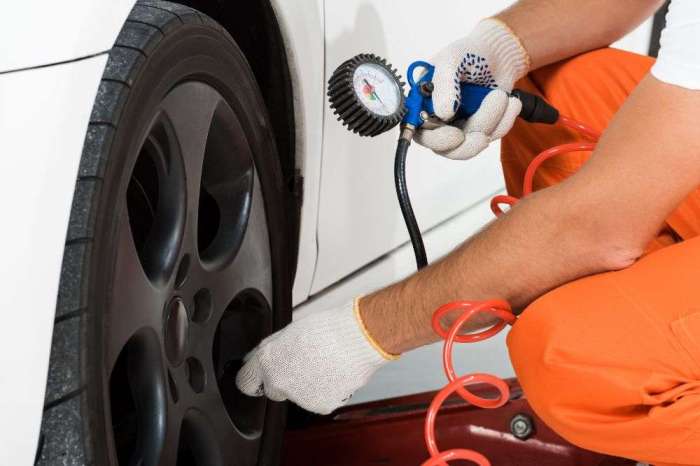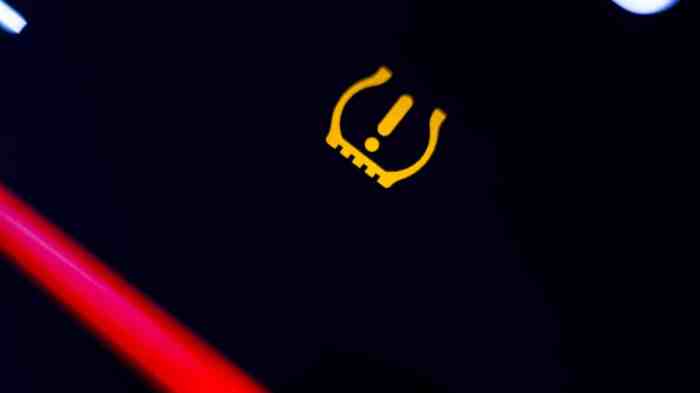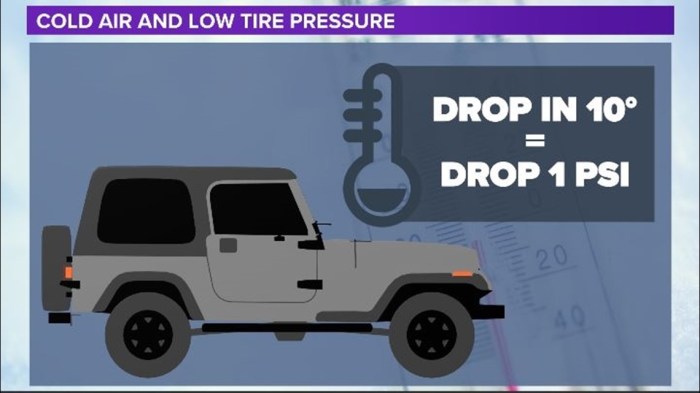Why is my tire pressure light on? That blinking red light is way more annoying than a roommate’s questionable music choices, right? It’s a total buzzkill, especially when you’re already running late for class. But before you panic and call AAA, let’s dive into the reasons behind that pesky warning. We’ll cover everything from understanding your car’s TPMS (Tire Pressure Monitoring System) to knowing when it’s time to call a pro.
Get ready to become a tire pressure guru!
This guide breaks down the common culprits behind a low tire pressure warning, from simple leaks to more serious mechanical issues. We’ll walk you through checking your tire pressure, understanding your TPMS, and recognizing when professional help is needed. Knowing your tires is crucial for safety and fuel efficiency – so let’s get started!
Understanding Tire Pressure Monitoring Systems (TPMS)

Your tire pressure light is more than just an annoying blink; it’s a vital safety feature linked to your car’s Tire Pressure Monitoring System (TPMS). Understanding how your TPMS works can help you stay safe and avoid costly repairs. This section breaks down the different types of TPMS, their components, and how they function.
TPMS System Types
There are two main types of TPMS: direct and indirect. Direct TPMS uses sensors within each tire to directly measure pressure and transmit that data to the car’s onboard computer. Indirect TPMS, on the other hand, relies on the car’s Anti-lock Braking System (ABS) wheel speed sensors to infer tire pressure. The ABS system detects differences in wheel rotation speed; if one tire is significantly underinflated, it will rotate faster than the others, triggering the TPMS light.
TPMS Components and Functions
A direct TPMS system includes several key components. Each tire has a sensor, a small electronic device that measures tire pressure and temperature. These sensors transmit data wirelessly to a receiver module, usually located within the car’s computer system. The receiver processes the data and displays it to the driver through a warning light on the dashboard.
Sometimes, the information might even be displayed numerically on the car’s infotainment screen. In an indirect TPMS, the ABS sensors are the primary component; the car’s computer uses the data from these sensors to estimate tire pressure.
TPMS Operational Steps (Direct System)
1. Pressure Measurement
The sensor in each tire continuously monitors the tire pressure and temperature.
2. Data Transmission
When the ignition is turned on, the sensors transmit their data wirelessly to the receiver module. This transmission usually happens at regular intervals, or when a significant change in pressure is detected.
3. Data Processing
The receiver module in the car receives the data from each sensor and compares it to the pre-set pressure thresholds.
4. Warning Indication
If the pressure in any tire falls below the threshold, the TPMS warning light illuminates on the dashboard. Some systems also provide a visual or audible alert, indicating which tire is low.
Direct vs. Indirect TPMS
| Feature | Direct TPMS | Indirect TPMS |
|---|---|---|
| Accuracy | High; directly measures pressure | Lower; infers pressure from wheel speed |
| Cost | Higher initial cost due to sensors in each tire | Lower initial cost; utilizes existing ABS sensors |
| Maintenance | Requires sensor battery replacement (every 5-10 years, depending on the make and model) | Generally less maintenance |
| Reliability | Generally more reliable due to direct pressure measurement | Can be affected by factors other than tire pressure (e.g., uneven road surfaces, tire wear) |
Common Causes of a Low Tire Pressure Warning Light
That annoying little tire pressure warning light? It’s usually not a sign of impending doom, but it definitely needs attention. Ignoring it can lead to some serious problems, so let’s dive into the most common culprits behind that flashing (or steadily glowing) indicator. Understanding why your light is on is the first step to getting back on the road safely and efficiently.A low tire pressure warning light illuminates when one or more of your tires fall below a pre-determined pressure threshold.
This threshold varies depending on your vehicle and tire specifications, but it’s generally around 25% below the recommended inflation pressure. Underinflation significantly impacts your vehicle’s performance and fuel economy.
Effects of Underinflation on Tire Performance and Fuel Efficiency
Driving on underinflated tires is like walking around in shoes that are two sizes too small – uncomfortable and potentially damaging. Underinflation leads to increased rolling resistance. This means your engine has to work harder to move the vehicle, leading to reduced fuel efficiency. You’ll notice a decrease in your gas mileage, potentially costing you more at the pump.
Furthermore, underinflation causes increased tire wear, specifically on the outer edges of the tire tread. This uneven wear shortens the lifespan of your tires and can create a dangerous driving condition. In extreme cases, underinflation can even lead to tire failure, resulting in a blowout – a situation nobody wants to experience. Think about the increased risk of accidents and the cost of replacing damaged tires – definitely not something to take lightly.
For example, if you consistently drive on underinflated tires, you could see a drop in fuel economy of up to 3% and experience significantly reduced tire life, potentially needing to replace them years earlier than expected.
Scenarios Triggering the Warning Light
Several everyday scenarios can cause your tire pressure warning light to illuminate. A slow leak, for instance, might not be immediately noticeable, but over time, it can gradually reduce tire pressure enough to trigger the warning. A puncture, even a small one, will obviously deflate your tire. Extreme temperature changes can also affect tire pressure; cold weather can significantly lower pressure, while hot weather can slightly increase it.
Finally, improper inflation is a common culprit. Many people simply don’t check their tire pressure regularly, leading to gradual deflation over time. For example, a sudden drop in temperature from 70°F to 30°F can cause a significant drop in tire pressure, easily triggering the warning light. Similarly, if you’ve recently had your tires rotated or changed, they might not have been properly inflated.
Troubleshooting Steps for a Low Tire Pressure Light, Why is my tire pressure light on?
A simple flowchart can help guide you through troubleshooting.[Imagine a flowchart here. The flowchart would begin with the question “Tire Pressure Warning Light On?”. A “Yes” branch would lead to checking tire pressure with a gauge. A “No” branch would end the flowchart. The “Check Tire Pressure” box would branch to “Pressure Low in One or More Tires?” A “Yes” branch would lead to locating and fixing the leak or inflating the tire to the correct pressure.
A “No” branch would lead to checking the TPMS system for malfunctions. The “Locate and Fix Leak/Inflate” box would lead to “Retest Tire Pressure” which would loop back to “Tire Pressure Warning Light On?”. The “Check TPMS System” box would lead to consulting a mechanic if the problem persists.]The flowchart visually represents the step-by-step process: check your tire pressure using a reliable gauge, locate and address any leaks or underinflation, and if the issue persists, consult a mechanic to ensure your TPMS system isn’t malfunctioning.
Remember, safety should always be your top priority.
Checking and Adjusting Tire Pressure

Okay, so your tire pressure light is on. You’ve figured outwhy* (hopefully!), now let’s get that thing fixed. This section covers the how-to of checking and adjusting your tire pressure. It’s easier than you think, and doing it regularly can save you a lot of headaches (and money!).
First things first: you need a tire pressure gauge. These are inexpensive and readily available at most auto parts stores, gas stations, and even some supermarkets. There are analog gauges (the kind with a needle) and digital gauges (which display the pressure numerically). Either type works fine; choose whichever you prefer. Make sure your gauge is accurate – a faulty gauge will only lead to more problems.
Locating Recommended Tire Pressure Information
The recommended tire pressure for your vehicle isn’t a random number; it’s specifically designed for your car’s weight, handling, and tire size. You can find this information in a couple of places. First, check your vehicle’s owner’s manual. This is the definitive source! The recommended tire pressure will usually be listed in a table, specifying the pressure for different tire sizes and loading conditions (e.g., carrying passengers or cargo).
Second, check the sticker located on your driver’s side doorjamb or the inside of the fuel filler door. This sticker provides the recommended tire pressure for your vehicle. This information is usually presented in PSI (pounds per square inch). It’s crucial to use the correct pressure specified for your tires.
Inflating Tires to the Correct Pressure
Once you know the recommended pressure, it’s time to inflate your tires. Most gas stations have air compressors available for use; some are free, while others may require payment. Here’s how to do it:
1. Remove the valve cap from the tire valve stem (the little metal stem sticking out of the tire).
2. Press the gauge firmly onto the valve stem. You should hear a hiss of air as the gauge reads the current pressure.
3. Compare the gauge reading to the recommended pressure from your owner’s manual or sticker. If the pressure is low, add air using the air compressor. Most compressors have a pressure gauge of their own; watch it carefully as you add air. Add air slowly to avoid overinflation.
4. Once you reach the recommended pressure, remove the gauge and replace the valve cap.
5. Repeat steps 1-4 for each tire.
Resetting the TPMS Warning Light
After inflating your tires to the correct pressure, the TPMS warning light might not go away immediately. The light usually requires a short driving period to recalibrate. However, some vehicles require a manual reset procedure. Consult your owner’s manual; the process varies depending on the make and model of your vehicle. Some common methods include driving the car for a certain distance, holding down a button on the dashboard for a few seconds, or using a scan tool.
The owner’s manual will have the specific instructions for your car.
Potential Problems Beyond Low Pressure
Okay, so your tire pressure light is on. We’ve covered low pressure, but sometimes the light’s a bit of a drama queen. There are other things that could be triggering that annoying little warning, and ignoring them could lead to bigger problems. Let’s dive into some of the less obvious culprits.
A faulty TPMS (Tire Pressure Monitoring System) sensor, a slow leak, or even a more serious tire issue could be the root cause. Understanding these possibilities is key to keeping you and your car safe on the road. We’ll explore some common problems and their telltale signs, helping you figure out what’s going on with your tires.
Faulty TPMS Sensors
TPMS sensors are small electronic devices located inside your tires. They measure pressure and transmit it to your car’s computer. These sensors can malfunction, sending inaccurate readings or failing to send any signal at all. This can result in a false warning light, even if your tire pressure is perfectly fine. A malfunctioning sensor might require replacement, and a mechanic can diagnose this using specialized equipment.
Sometimes, the problem is simply a dead battery within the sensor, which can be easily replaced.
Signs of Punctures and Slow Leaks
A slow leak might not immediately deflate your tire, but it will gradually decrease pressure over time, eventually triggering the TPMS light. Obvious signs include a noticeable loss of pressure over a few days, a hissing sound when near the tire, or a visible puncture in the tire’s sidewall or tread. A nail or screw embedded in the tire is a classic example.
A more subtle leak might be harder to spot, and a professional inspection might be needed.
Risks of Driving with Significantly Low Tire Pressure
Driving on significantly under-inflated tires is dangerous. Low pressure increases the tire’s rolling resistance, leading to reduced fuel efficiency. More importantly, it causes excessive heat buildup within the tire, increasing the risk of a blowout. This can lead to loss of control, potentially resulting in an accident. Under-inflation also leads to uneven wear and tear, shortening the lifespan of your tires and potentially damaging the wheel rims.
Think of it like this: driving on under-inflated tires is like running a marathon on worn-out sneakers – it’s inefficient, uncomfortable, and risky. For example, a tire with significantly low pressure can overheat and fail catastrophically at highway speeds, leading to a dangerous loss of control.
Okay, so your tire pressure light’s on – total bummer, right? It could be a slow leak, or maybe you just need to add some air. But seriously, while you’re checking your tires, you might want to think about car security, especially if you’ve got a fancy ride. Check out this article on Luxury car theft prevention devices 2025 for some peace of mind.
Anyway, back to that tire – make sure to check all four, and inflate them properly!
Potential Tire Problems and Their Symptoms
It’s important to understand that a lit TPMS light isn’t always just about pressure. Several tire-related problems can trigger it.
Here’s a list of potential tire problems and their associated symptoms:
- Underinflation: TPMS light illuminated, noticeable softness in the tire, reduced fuel efficiency.
- Puncture: TPMS light illuminated, rapid or gradual pressure loss, visible hole or object embedded in the tire, possible hissing sound.
- Slow Leak: TPMS light illuminated after a period of time, gradual pressure loss, no visible puncture (leak may be in the sidewall or valve stem).
- Faulty TPMS Sensor: TPMS light illuminated, no other noticeable tire problems, pressure readings may be inconsistent or erratic.
- Bent or Damaged Rim: TPMS light might be illuminated, uneven tire wear, vibration or shaking while driving, visible damage to the wheel rim.
- Tire Tread Separation: TPMS light may or may not be illuminated, unusual vibrations or noises while driving, bulging or deformation of the tire sidewall, this is extremely dangerous and requires immediate attention.
Visual Inspection of Tires: Why Is My Tire Pressure Light On?

Okay, so your tire pressure light is on. You’ve checked the pressure (hopefully!), but a visual inspection is just as crucial. Seeing is believing, and your eyes can often tell you more than a gauge alone. A quick look-see can reveal problems that a pressure reading might miss.A properly inflated tire looks round and plump, with the tread contacting the ground evenly across its width.
The sidewalls should appear smooth and free from any bulges, cuts, or embedded objects. The tread should show a consistent depth across the entire tire surface. Think of a perfectly round balloon – that’s your goal. Significant deviations from this ideal image warrant further investigation.
Underinflation, Overinflation, and Tire Damage
Underinflation, overinflation, and damage all manifest visually. An underinflated tire will appear flatter and the sidewalls will bulge outward more prominently. The contact patch with the road will be wider than normal. Conversely, an overinflated tire will look more rounded and have less contact with the ground; the sidewalls will be more taut and may even appear slightly pinched.
Damage, on the other hand, presents in a variety of ways, often involving irregularities in the tire’s shape or tread.
Examples of Tire Damage
Several types of tire damage can trigger the warning light. Punctures, for example, are fairly obvious – a hole in the tire, usually accompanied by rapid deflation. A slow leak might not be immediately visible, but close inspection might reveal a small puncture or a crack in the sidewall. Bulges are more serious; these are often caused by internal damage or structural weakness, where the tire’s internal structure has separated from the outer layers, creating a noticeable swelling on the sidewall.
Other damage includes cuts, embedded objects (like nails or screws), and wear and tear that goes beyond normal usage. Deep cuts or significant wear can compromise the structural integrity of the tire and lead to pressure loss.
That tire pressure light? It’s a total bummer, right? Low pressure is a common culprit, but sometimes it’s something more serious like a slow leak, which could even be related to misaligned wheels. If you need to get that checked, you might want to look into the Wheel alignment cost at Pep Boys to see how much a fix might cost.
Anyway, make sure you check your tires regularly to avoid further issues!
Visual Descriptions of Tire Problems
Imagine a tire with a slow leak. It won’t be completely flat, but it’ll look slightly deflated compared to its siblings. The sidewalls will be a bit more prominent, and the tread might appear slightly less taut. Now, picture a puncture. This is more dramatic.
You’ll likely see a hole, maybe even an object sticking out of the tire. The tire will rapidly deflate, becoming visibly flat or very close to it. Finally, consider a bulge. This is a more serious issue. You’ll see a distinct, often localized swelling on the sidewall, almost like a bubble under the tire’s surface.
This bulge indicates a separation within the tire’s layers, significantly compromising its structural integrity and posing a safety hazard.
When to Seek Professional Help
That tire pressure light? It’s not just a pesky annoyance; it’s a crucial indicator of your vehicle’s safety and performance. While you can handle some tire issues yourself, knowing when to call in a pro is essential for avoiding costly repairs and potential accidents. Ignoring a persistent problem can lead to more significant issues down the road, literally.Regular tire maintenance and inspection are vital for extending the life of your tires and ensuring safe driving.
Think of it like regular checkups for your car – you wouldn’t ignore a persistent cough, would you? The same principle applies to your tires. Consistent monitoring and timely intervention can prevent small problems from escalating into major headaches (and expenses).
Consequences of Ignoring a Low Tire Pressure Warning
Driving on underinflated tires significantly increases the risk of a blowout. This can lead to loss of control, potentially resulting in accidents. Beyond safety concerns, underinflation also increases tire wear, reduces fuel efficiency, and puts extra strain on your vehicle’s suspension components, leading to premature wear and tear. For example, consistently driving on severely underinflated tires could shorten their lifespan by several thousand miles and significantly increase your fuel consumption.
This translates directly into higher costs for replacement tires and increased gas expenses.
Choosing a Reputable Tire Service Provider
Finding a trustworthy tire shop is crucial. Look for shops with positive online reviews, certifications from reputable organizations (like those specializing in tire safety), and a history of providing quality service. Don’t hesitate to ask about their experience with your specific vehicle’s make and model, and inquire about their warranty policies. Check if they use advanced tire pressure monitoring system (TPMS) tools for accurate readings and recalibration if needed.
Word-of-mouth recommendations from friends or family can also be invaluable. Consider factors like price transparency and the overall professionalism of the staff when making your decision. A slightly higher price for a known reputable service provider often outweighs the potential risks and costs associated with choosing a cheaper, less reliable option.
Last Point
So, that annoying tire pressure light? It’s not just a minor inconvenience; it’s a safety indicator. Understanding your car’s TPMS, knowing how to check your tire pressure, and recognizing the signs of a problem are key to avoiding flat tires, improving your fuel economy, and keeping you safe on the road. Don’t ignore that light – a quick check could save you a lot of trouble (and maybe a hefty tow bill!).
Now go forth and conquer those tires!









